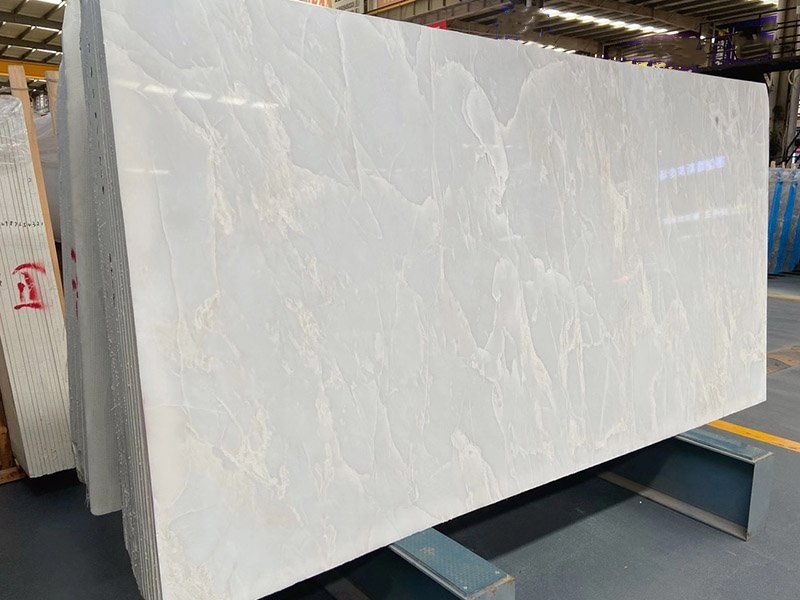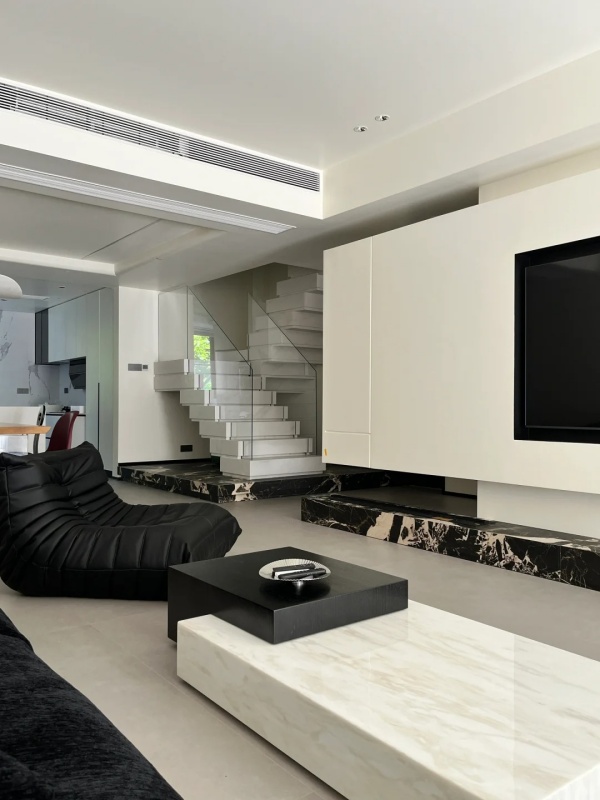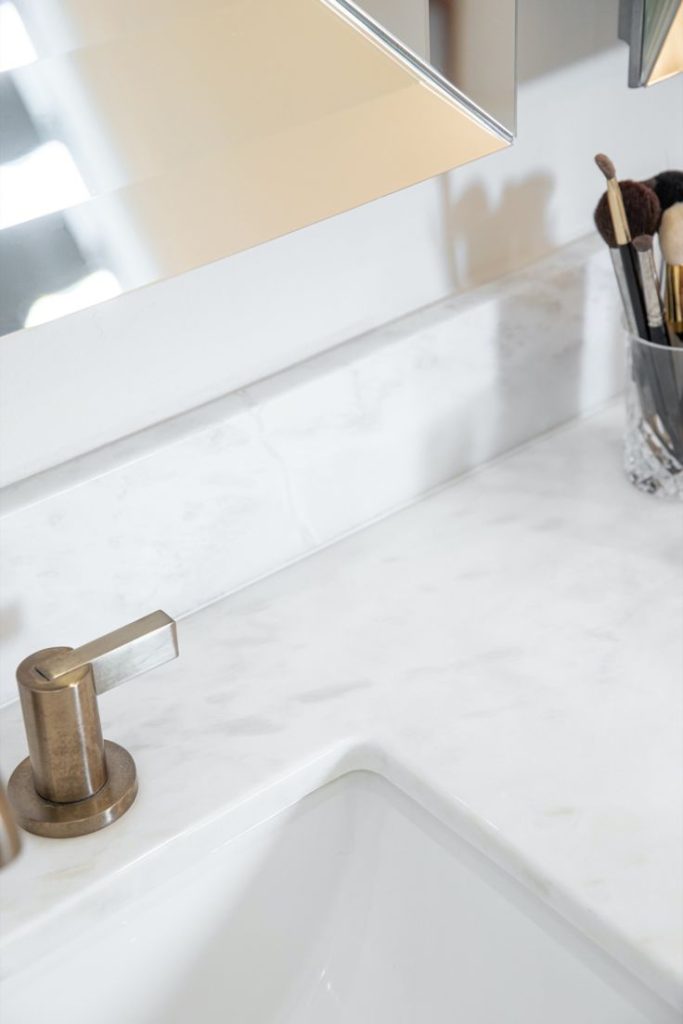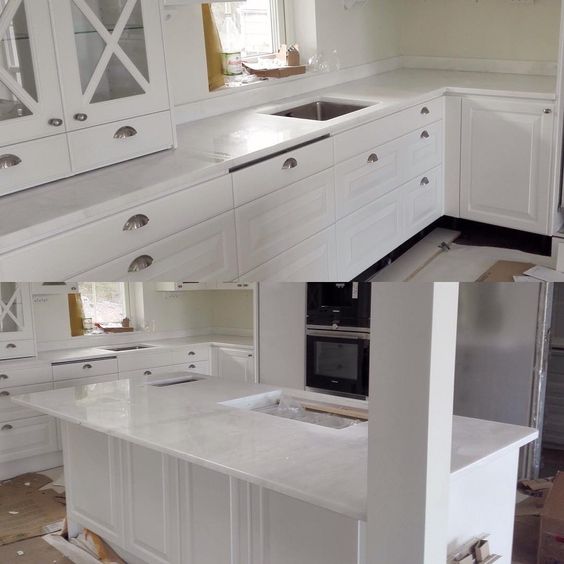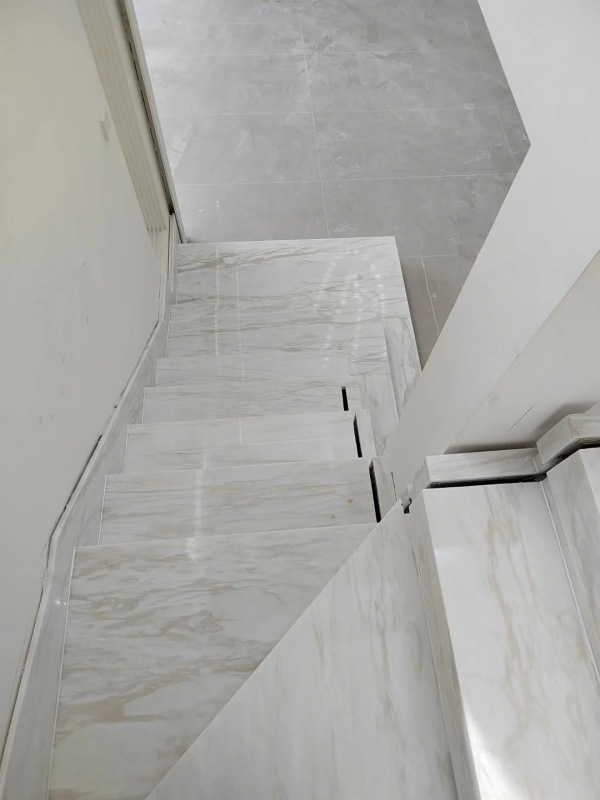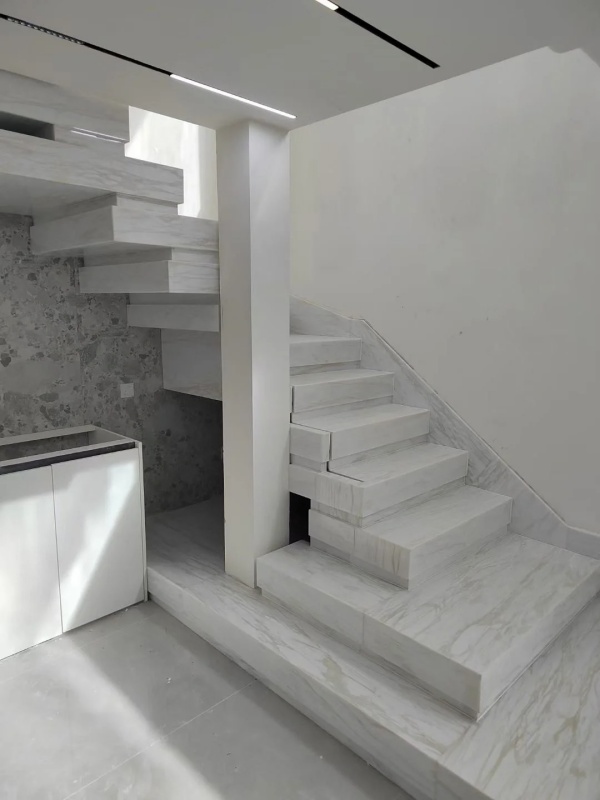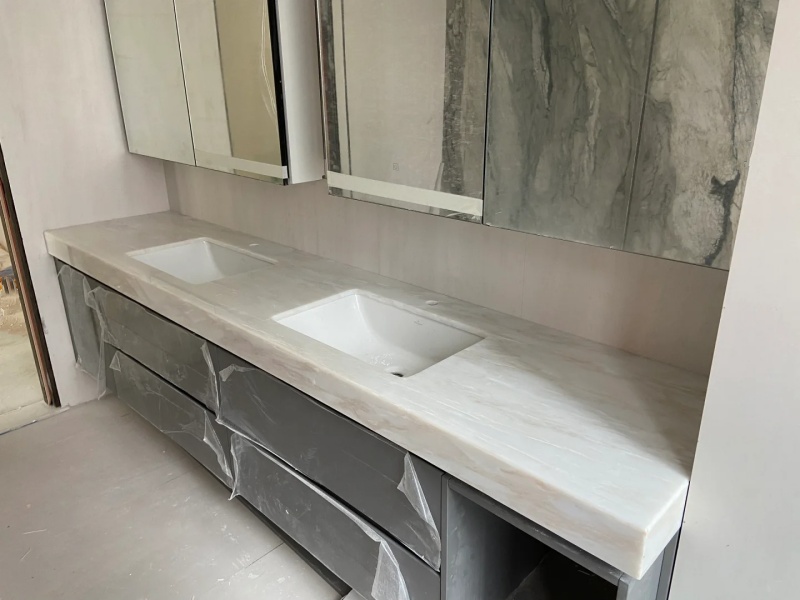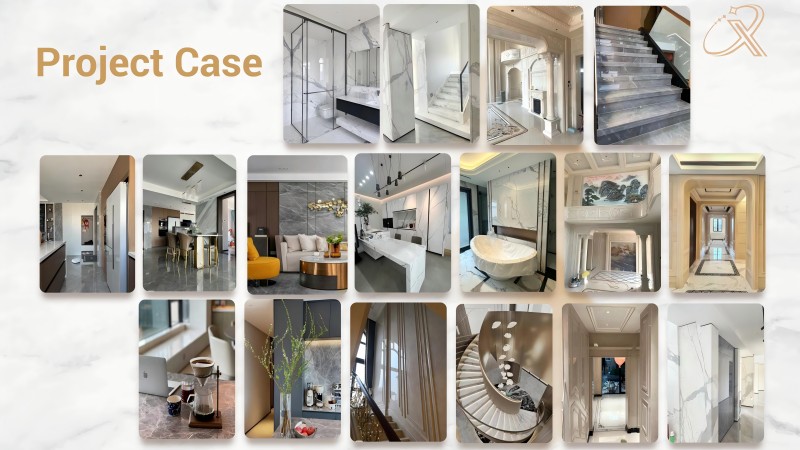Bianco Rhino marble, also called Rhino White or White Rhino marble, is a luxurious, natural marble originating from Namibia. Known for its creamy white base with subtle veins of beige, gold, and grey, Bianco Rhino marble has a smooth, uniform look and a warm aesthetic. Its gentle veining and soft tone make it a popular choice for creating sophisticated spaces, commonly used in countertops, bathroom surfaces, and flooring.
This marble’s qualities allow it to pair well with both modern and classic interior styles, adding a sense of elegance and luxury while maintaining a light, airy feel. Its relative durability compared to some other marbles also makes it suitable for high-traffic areas, although it still requires careful maintenance to prevent staining or etching.
Bianco Rhino marble is valued for both its aesthetic appeal and its distinctive qualities. Here are some additional details:
Appearance and Variations
The stone’s creamy white base often has warm undertones with faint veins that range in color from light beige to soft gold and sometimes even light gray. The veining patterns are subtle and lend a sense of depth without overpowering the stone’s overall look. This gives it a more cohesive and refined appearance, setting it apart from marbles with more dramatic contrasts like Carrara or Calacatta. Each slab is unique, with some slabs featuring minimal veining for a pure white look and others showcasing slightly more pronounced vein patterns.
Composition and Strength
Bianco Rhino marble is composed primarily of calcite, which gives it a softer feel than granite but slightly harder than traditional Italian white marbles like Carrara. This slight hardness adds durability, making it suitable for high-traffic spaces such as kitchens and bathrooms. It’s known for being resistant to chipping, though it’s still susceptible to scratching and etching if exposed to acidic substances. As with all marbles, it’s best to seal the surface periodically to enhance its resistance to staining and water absorption.
How does Bianco Rhino Marble compare to other natural stones in terms of durability?
Bianco Rhino marble has a reputation for being slightly more durable than some other classic white marbles, but it’s still softer and more porous than many other natural stones like granite and quartzite. Here’s how it compares to various popular natural stones in terms of durability:
1. Granite
- Durability: Granite is one of the hardest natural stones, making it highly resistant to scratches, heat, and etching. It’s non-porous when sealed properly, meaning it’s much less likely to stain or absorb liquids.
- Comparison: Bianco Rhino is softer and more porous than granite, which means it can scratch, stain, and etch more easily. Granite requires less maintenance overall and is a better option for high-traffic areas or where heavy use is expected.
2. Quartzite
- Durability: Quartzite is known for being one of the hardest and most durable natural stones, nearly as hard as granite but with a marble-like appearance. It’s scratch- and heat-resistant and highly resistant to etching, which makes it ideal for kitchens and bathrooms.
- Comparison: Bianco Rhino marble is softer and can stain or etch if exposed to acidic substances, while quartzite remains unaffected by most household acids. Quartzite is a better choice for durability, though Bianco Rhino is often chosen for its warmer tones and softer look.
3. Carrara Marble
- Durability: Carrara marble, a classic white marble from Italy, has a similar composition to Bianco Rhino and is also prone to scratching, etching, and staining. Like Bianco Rhino, it requires regular sealing and careful cleaning.
- Comparison: Both Carrara and Bianco Rhino have similar characteristics in terms of maintenance and durability. However, Bianco Rhino is often considered slightly more durable, with a less porous composition, making it a better option for spaces where there’s a little more activity.
4. Calacatta and Statuario Marble
- Durability: Calacatta and Statuario are premium Italian marbles known for their striking veining. Like Bianco Rhino, they are softer and more prone to scratching and staining than granite or quartzite.
- Comparison: These marbles are similar in durability to Bianco Rhino, though they tend to be even more porous. Bianco Rhino has a subtle veining pattern, making it a good alternative for those looking for a lower-maintenance option with a lighter aesthetic.
5. Soapstone
- Durability: Soapstone is softer than most natural stones and can scratch, but it’s non-porous and doesn’t stain or etch. Over time, scratches can be buffed out or add to the stone’s patina.
- Comparison: While Bianco Rhino can stain or etch, soapstone is impervious to staining, making it lower maintenance overall. However, soapstone doesn’t offer the polished, high-end look of Bianco Rhino and is often preferred for rustic or industrial styles.
6. Limestone and Travertine
- Durability: Limestone and travertine are softer stones, even more prone to scratching and etching than Bianco Rhino marble. They are extremely porous, requiring frequent sealing and maintenance.
- Comparison: Bianco Rhino is slightly more durable than both limestone and travertine, making it a slightly better choice for areas where durability is a concern but the aesthetic of a light-colored stone is desired.
Summary
Bianco Rhino marble is a good middle-ground choice among natural stones when considering durability and appearance. It provides a higher level of durability compared to classic Italian marbles but doesn’t reach the toughness of granite or quartzite. For applications where both beauty and moderate durability are important, Bianco Rhino offers a balance, but it requires regular sealing and mindful care to keep it looking its best.
What’s the Application of Bianco Rhino Marble?
Bianco Rhino Marble a range of high-end interior projects since its beauty and unusual tint are widely appreciated.
- Bianco Rhino Marble countertop :Bianco Rhino Marble is often used to create stunning kitchen countertops and bathroom vanity tops. Its striking white color and intricate veining add elegance and sophistication to these spaces.
2.Wall Cladding: As a wall covering,Bianco Rhino Marble can create a focal point in any room. It is used in both residential and commercial settings to enhance the visual appeal of walls.
3.Flooring: While it is less commonly used for flooring compared to harder stones like granite ,Bianco Rhino Marble still be used in areas with light foot traffic, such as bathrooms, entryways, and other interior spaces.
4.Feature Walls: The dramatic veining and color variations of Bianco Rhino Marble make it ideal for creating accent walls or feature walls in living rooms, dining rooms, or even hotel lobbies.
5.Decorative Items: Smaller pieces of Bianco Rhino Marble, such as tabletops, fireplace surrounds, and decorative objects, can be used to add a touch of luxury and sophistication to interior design.
6.Bathroom Applications: Besides vanity tops,Bianco Rhino Marble can be used for shower walls, bathtub surrounds, and other bathroom surfaces to create a spa-like atmosphere.
7.Furniture: Custom furniture items like side tables, dining tables, and coffee tables. These works of art that are also useful elevate any room. Each furniture piece is distinctive and draws attention because of the distinctive patterns and colours of this Bianco Rhino Marble
8.Art Installations: Designers and artists frequently work with Bianco Rhino Marble to produce one-of-a-kind art installations. In galleries, public areas, and private collections, artistic works are made stand out by the depth and personality that the natural beauty of the stone provides.
What are the unique features of Bianco Rhino Marble that make it appealing for interior design?
Bianco Rhino marble stands out for its aesthetic and functional qualities that make it especially appealing for interior design. Here are some unique features that set it apart:
1. Warm, Creamy Tone
- Uniqueness: Unlike the colder, grayish tones of some popular marbles like Carrara, Bianco Rhino marble has a warmer, creamy white base with soft golden or beige veining. This adds a welcoming, warm atmosphere to spaces, making it ideal for homes aiming for a cozy but luxurious feel.
- Interior Design Appeal: Its subtle warmth complements a wide range of interior design styles, from traditional to contemporary, allowing it to blend easily with wood, brass, and other warm-toned elements.
2. Soft, Subtle Veining
- Uniqueness: Bianco Rhino’s veining is usually soft and delicate, with shades of light beige, grey, or sometimes even a hint of gold. Unlike marbles with bold, dramatic veining, Bianco Rhino’s patterns are understated, offering a more harmonious look.
- Interior Design Appeal: This softer veining pattern makes it versatile and suitable for both large installations (like flooring or feature walls) and smaller, detailed applications (like vanity tops), without overwhelming the space. It’s particularly attractive in minimalist or modern designs that seek a touch of elegance without distraction.
3. Luminous, Polished Finish
- Uniqueness: When polished, Bianco Rhino marble has a luminous, glossy surface that reflects light beautifully. This quality can make rooms feel larger and more open, particularly effective in spaces that lack natural light.
- Interior Design Appeal: Its polished finish not only highlights the marble’s veining and color depth but also enhances the luxurious vibe of the space. This makes it a popular choice for bathrooms, lobbies, and other high-impact areas that benefit from a bright, reflective surface.
4. Versatility Across Design Styles
- Uniqueness: Bianco Rhino marble’s neutral yet warm palette allows it to be incredibly adaptable to various design aesthetics. Whether in a modern, minimalist space or a traditional, classic setting, this marble complements diverse styles.
- Interior Design Appeal: Designers appreciate the marble’s ability to pair well with a variety of materials, like wood, metal, glass, and concrete. It can take on a bold look in modern spaces or offer a timeless, elegant touch in traditional designs.
5. Relative Durability
- Uniqueness: Compared to other high-end marbles, Bianco Rhino is slightly denser and less porous. This added durability gives it an edge in areas where some marbles might be too fragile or prone to staining.
- Interior Design Appeal: This quality makes it practical for kitchens, bathrooms, and other high-traffic areas where its resilience is a valuable asset. Designers can achieve a luxurious look without compromising too much on maintenance needs.
6. Luxurious Yet Subtle Aesthetic
- Uniqueness: Bianco Rhino marble’s elegant, muted patterns lend it a sophisticated but not overly ornate appearance. This makes it less intimidating and more accessible for varied design projects.
- Interior Design Appeal: Its refined appearance allows it to act as a statement material while remaining soft and approachable. It’s commonly used in accent walls, countertops, fireplace surrounds, and even custom furniture pieces for a high-end look that doesn’t overpower.
7. Compatibility with Natural and Neutral Color Palettes
- Uniqueness: The warm tones and subtle veining of Bianco Rhino make it an excellent choice for spaces with natural or neutral color schemes. Its colors echo natural elements, blending seamlessly with earthy hues, wood tones, and plant accents.
- Interior Design Appeal: This compatibility with natural and neutral palettes means it’s often used in biophilic or organic designs, as well as in spaces that focus on calm, natural aesthetics, like spas, wellness centers, and tranquil home spaces.
8. Enhanced Light Reflection
- Uniqueness: The pale tone and polished finish of Bianco Rhino help reflect light, brightening spaces and giving them an airy feel. Its slightly translucent quality, when backlit, creates a gentle glow that adds depth and elegance.
- Interior Design Appeal: Designers use this feature to open up smaller or darker rooms, as the marble’s light reflection contributes to a feeling of spaciousness and brightness. When used as wall cladding or large floor tiles, it can transform the atmosphere, making it feel open and inviting.
These features make Bianco Rhino marble a go-to choice for spaces that aim to combine luxury with a soft, approachable ambiance, blending timeless elegance with practical versatility. Its appeal lies not only in its beauty but also in its adaptability to various design needs and preferences.
Factors affecting Bianco Rhino Marble price?
The price of Bianco Rhino marble is influenced by various factors that impact its availability, quality, and demand in the market. Here are the main factors that affect its cost:
1. Quality and Grade
- Effect: Bianco Rhino marble comes in different grades based on quality factors like color uniformity, clarity of veining, and presence of imperfections. Higher-grade slabs with consistent coloring, minimal veining, and fewer natural defects (such as fissures or spots) are more expensive.
- Market Impact: Premium-quality slabs are often in higher demand and fetch a higher price because they are rarer and preferred for luxury projects. Lower grades with more prominent veining or imperfections can offer a budget-friendly option but may not be as visually refined.
2. Slab Size and Thickness
- Effect: Larger slabs with greater thickness are generally more expensive. A standard thickness is around 2 cm, but 3 cm slabs, which are stronger and more durable, command a premium.
- Market Impact: The cost of thicker and larger slabs is higher due to the additional material and greater difficulty in handling and transport. These larger or thicker slabs are often chosen for expansive projects or high-end installations where seamlessness and durability are prioritized.
3. Extraction and Transportation Costs
- Effect: Bianco Rhino marble is primarily quarried in Namibia, meaning its price reflects the cost of extraction, labor, and long-distance shipping to international markets. These costs can fluctuate based on fuel prices, import duties, and local labor costs.
- Market Impact: Transportation and extraction costs are passed on to consumers, so fluctuations in these areas directly affect pricing. Regions closer to the quarries may see slightly lower prices, while costs tend to be higher in distant markets due to shipping and logistics.
4. Market Demand and Trends
- Effect: Trends in interior design can heavily impact the demand for Bianco Rhino marble. When warm-toned stones or cream-colored marbles are in style, the demand increases, often leading to higher prices.
- Market Impact: If Bianco Rhino becomes highly sought after for high-end projects, limited supply can drive up prices. Conversely, when other marble varieties are trending, the price might stabilize or even drop as demand lessens.
5. Availability and Quarry Yield
- Effect: The availability of Bianco Rhino marble depends on the yield of the quarries in Namibia. Since marble is a natural stone, not all extracted blocks meet the standards for Bianco Rhino’s characteristic color and veining.
- Market Impact: When quarry yields are low, prices can rise due to scarcity. Conversely, if quarry output is high, the market might see a temporary price drop. Factors like mining conditions and seasonal weather patterns can also impact quarry productivity.
6. Finishing Type
- Effect: The finish applied to Bianco Rhino marble affects the cost, with polished and honed finishes typically costing less than specialized finishes like leathered or brushed. Certain finishes require additional labor and treatment, which can raise the price.
- Market Impact: Finishing choices can significantly impact the overall price, as more labor-intensive finishes are often in demand for high-end, custom projects. Polished and honed finishes tend to be more affordable and widely available.
7. Customization and Cutting Requirements
- Effect: Custom shapes, edge details, or specific dimensions increase the price of Bianco Rhino marble due to the additional labor and waste involved in cutting and shaping the stone. Intricate details like waterfall edges or intricate inlays also increase cost.
- Market Impact: Projects requiring custom cuts or unique designs (e.g., intricate flooring patterns, carved sinks) typically incur higher material and labor costs, impacting the final price.
8. Installation Complexity
- Effect: Although installation isn’t directly part of the stone’s price per se, the complexity of the installation can affect the total cost of a Bianco Rhino marble project. The marble’s relatively soft nature requires skillful handling, especially in complex installations.
- Market Impact: Complex projects with custom installations, larger slabs, or intricate designs require experienced installers and specialized equipment, which raises the cost. Regions with limited skilled labor may see even higher prices due to the expertise required.
9. Supplier and Brand Markup
- Effect: Different suppliers or brands may apply varying markups based on reputation, customer service, quality guarantees, or sourcing exclusivity. Branded or exclusive sources may charge more, particularly if they provide premium quality or sustainable sourcing certifications.
- Market Impact: Established suppliers with a strong market reputation or exclusive access to high-quality quarries may charge a premium, which impacts the final price. Shopping around and comparing suppliers can sometimes yield more competitive prices.
10. Currency Exchange Rates
- Effect: Since Bianco Rhino is imported from Namibia, fluctuations in currency exchange rates between the exporting and importing countries can impact pricing.
- Market Impact: When the local currency weakens against the Namibian dollar, the cost of imports rises, affecting prices in regions where Bianco Rhino is in demand. Conversely, favorable exchange rates may lead to lower prices.
11. Environmental and Ethical Sourcing Practices
- Effect: Marble sourced with environmentally responsible and ethically sound practices tends to be priced higher due to the added cost of compliance with regulations, sustainable quarrying practices, and fair labor compensation.
- Market Impact: Some consumers prioritize sustainability and ethical sourcing, so marble that meets these standards may carry a higher price tag. Certification or eco-labels can further elevate the cost but add appeal to conscious buyers.
In summary, the price of Bianco Rhino marble is determined by factors including quality, size, transportation, market demand, and finishes, with significant impact from global logistics, ethical practices, and customizations. For buyers, understanding these variables can help in budgeting and selecting the best options for specific design needs.
Why Opt For Xiamen Funshine Stone?
1.Our design consultation service at Funshine Stone gives our customers peace of mind, high-quality stone, and professional guidance. Our expertise lies in natural stone design tiles, and we offer comprehensive “top to bottom” consulting to realize your idea.
2.With a combined 30 years of project expertise, we have worked on a vast array of projects and established enduring relationships with numerous people.
3.With a huge assortment of natural and engineered stones, including marble, granite, bluestone, basalt, travertine, terrazzo, quartz, and more, Funshine Stone is pleased to provide one of the largest selections available. It is clear that our use of the best stone available is superior.








